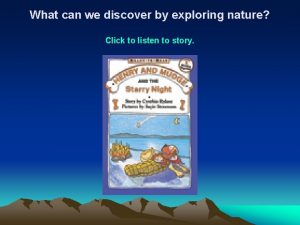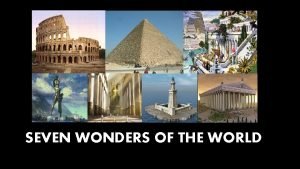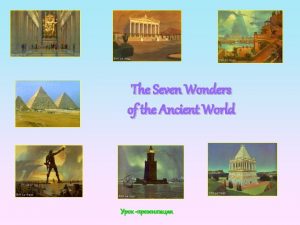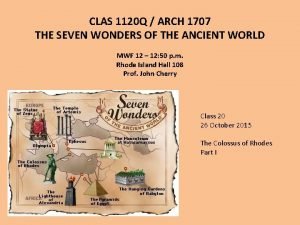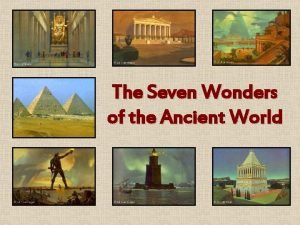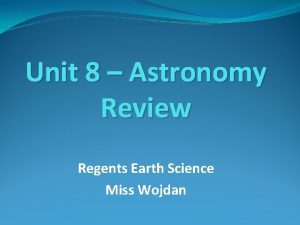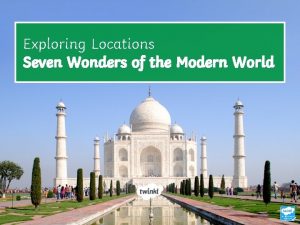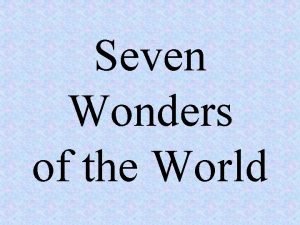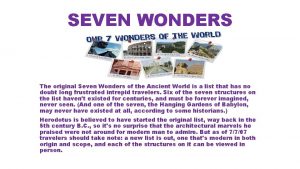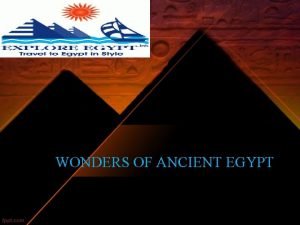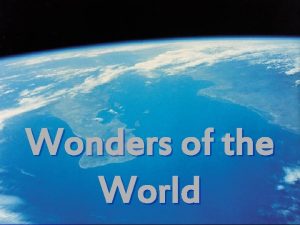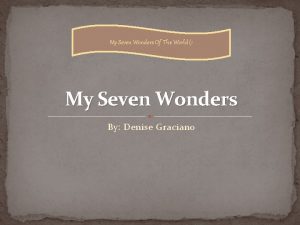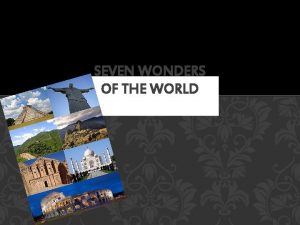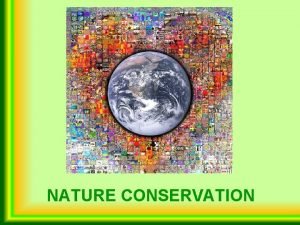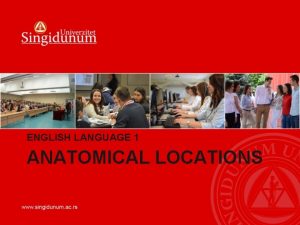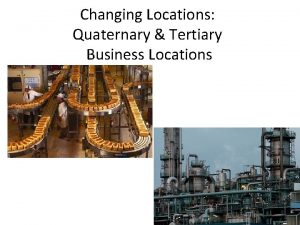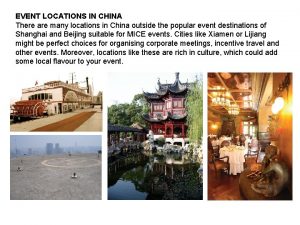Exploring Locations Seven Wonders of Nature Seven Wonders

















- Slides: 17

Exploring Locations Seven Wonders of Nature

Seven Wonders of Nature In 2011, a list of the top seven wonders of the nature was compiled. Around 500 million votes from all over the world were cast to select the seven most unique, beautiful, un-touched, ecologically significant and historically important natural features around the world.

Iguazu Falls

Iguazu Falls The Iguazu Falls are the largest waterfalls in the world. They are found on the Iguazu River on the Argentina-Brazil border. There are 275 drops ranging between 60 and 82 meters tall and stretching over 1. 7 miles. Up to 13, 000 cubic meters of water flows over the falls every second, most of which is channelled towards the falls via Devil’s Throat, a vast U-shaped chasm located just before the waterfalls begin. Approximately 135 million years ago, a huge volcanic eruption flooded the desert (as it was then) with tons of basalt lava. The lava flowed and cooled at different speeds, creating a very uneven “stepped” terrain. Over the centuries, this basalt rock has been cracked and shaped by further earthquakes and movements. The Iguazu Falls were formed 20, 000 years ago when water from the Iguazu River began flowing over the uneven basalt rock. The constant water flow is eroding the basalt rock and causing the waterfalls to move backwards. The original falls are thought to have been 28 kilometers further downstream than they are today. At its peak, Iguazu Falls attracted 1. 2 million visitors per year, all of whom enjoy the spectacular views and awe inspiring force of the falls from the specially created walkways and platforms around the site. They can also be seen in many films, including ‘Indiana Jones and the Kingdom of the Crystal Skull’ (2008), ‘Miami Vice’ (2006) and ‘Happy Together’ (1997).

Ha Long Bay

Ha Long Bay in Vietnam is made of limestone and made up of around 2000 mini islands and karsts formed by the dissolution of the limestone rock by the ocean. The karsts have formed over 20 million years and are home to over 70 native species of plants and animals. Ha Long Bay is the biggest and best preserved example of marine invaded tower karsts in the world. The tropical climate and evergreen forests have created a rich biosystem on land in the oceans. The animals include deer, weasels and white-tabby and redhaired monkeys, alongside 37 species of birds, 107 species of fish and 163 different species of coral. Most areas of the bay are uninhabited and untouched by humans, giving them a unique and spectacular ecosystem, biodiversity and landscape. The area is extremely popular with tourists and attracts 5. 5 million visitors per year. Most of these visit the bay on cruise ships. There is an ongoing struggle between the tourism industry and the conservation and preservation of this area of global interest and importance.

Jeju Island

Jeju Island is a volcanic island formed approximately two million years ago. The island remained uncultivated for the majority of its history, leading to the growth of pristine primary forest with a unique ecosystem and biodiversity. Seongsan Ilchulbong is a volcanic tuff cone off the north-east coast of Jeju Island. It is a large, circular crater surrounded by steep sea-cliffs, one of the best examples of one of these features in the world. The Manjanggul lava tube is noted as being scientifically significant as it thought to be up to 300, 000 years old and remains so well preserved. A lava tube is a long tunnel formed by hot lava flowing beneath a crust of hardened lava. Mount Hallasan is a shield volcano that can be seen from everywhere on Jeju Island. The body of Hallasan forms the bulk of Jeju Island itself. It is worshipped by local people as they believe that gods and spirits live inside the volcano.

Jeju Island

Amazon River The Amazon River is the second longest river in the world (4345 miles) but the largest in terms of the amount of water that flows through it. It discharges approximately 6, 591 cubic kilometres of water every year and accounts for one fifth of the world’s total river flow. The vast amounts of freshwater carried by the river dilute the saltiness of the ocean for 100 miles around the river’s mouth. The Amazon River flows through six countries – Brazil, Peru, Colombia, Ecuador, Bolivia and Venezuela, passing through highland, lowland, rainforest and savanna and supporting over 2, 500 species of fish alone. There also thousands of mammals, amphibians, water snakes, plants, trees and humans who depend on the river for survival. Some of these animals – including the pink river dolphin, the giant river otter, the piranha, the Amazonian manatee, the tucuxi dolphin, giant Amazon river turtle, arapaima fish, electric eel, dwarf caiman, and green anaconda – are unique to the Amazon River and are at great danger of extinction if the ecosystem of the river basin changes.

Komodo Island

Komodo Island is one of the 17, 508 islands that make up Indonesia. It is 150 square miles in size and is home to just 2000 people. The island gives its name to its most famous and highly aggressive resident and the largest lizard on Earth: the Komodo dragon. There approximately 5700 lizards on the Island, almost triple the number of humans. The island is designated as a national park to protect the Komodo dragon, its habitat and the biodiversity of the whole island its surrounding ocean. The Island is also home to the Timor deer (favourite food of the Komodo dragon) and the orange-footed scrub fowl, and is surrounded by coral reefs, mangroves, seagrass beds and semi-enclosed bays. The sea life includes: manta rays, sharks, sea turtles, dolphins, fish, dugong and 14 species of whale. Around 45, 000 visitors travel to Komodo Island every year. This is beginning to threaten the habitat of the native species and needs to be carefully managed by the government and the local people who depend on tourism for a living.

Puerto Princess Underground River Photo courtesy of (Jimaggro@flickr. com) - granted under creative commons licence – attribution

Puerto Princess Underground River (PPUR) flows beneath the St. Paul Mountains on the island of Palawan in the Philippines. It is the world’s longest navigable underground river and receives 1. 2 million visitors every year. You join the underground river through a cave just north of Puerto Princess and travel the 8. 2 kilometres underground until you reach the South China Sea. Only the bravest explorers can travel the entire length as some parts of the cave are too narrow for the boat and visitors have to swim in complete darkness between the rock walls. Other sections of the caves are enormous cathedral-sized spaces with limestone spindles, mushroom-shaped rocks, glimmering crystals and underground waterfalls creating a spectacular, echoing cavern. The PPUR is a unique ecosystem, home to thousands of giant spiders, bats, crabs, swallows, fish and snakes, many of which can only be found here and live their entire lives in these caves. The caves and river are a UNESCO World Heritage Site and a Philippine National Park as well as being voted one of the seven wonders of nature in 2011.

Table Mountain

Table Mountain is located in Cape Town, South Africa and gets its name from its two-mile-wide flat top and very steep cliff sides. It is a global landmark and the most recognisable iconic image of South Africa. It is one of the oldest mountains on Earth (six times older than the Himalayas) and is made from granite and sandstone, formed deep underneath the ocean 800 million years ago. The shape of the mountain was created by erosion and ice sheets flattening the rock during the ice age 300 million years ago. The Mountain has a very unique ecosystem and is home to over 2000 plant species, over 70% of which are rare and only grow on or near Table Mountain. There also many animal species living on the Mountain, including its most famous resident: the marmot. The ecosystem created by the mountain including its soil, forests, rain shadow and mountain streams support human life and made the area an ideal place to settle, this settlement is now known as Cape Town. There is an Aerial Cableway that transports visitors to the top of the mountain. This alone attracted 1 million visitors in 2016 and that doesn’t include thousand of people who climb the mountain along one of its access routes every year.

 List of things a to z
List of things a to z What can we discover by exploring nature
What can we discover by exploring nature Jocelyn vazquez
Jocelyn vazquez Woders of the world
Woders of the world Seven wonders of the world 2012
Seven wonders of the world 2012 New seven wonders foundation
New seven wonders foundation Lighthouse seven wonders of the ancient world
Lighthouse seven wonders of the ancient world Dali seven wonders
Dali seven wonders Taj mahal seven wonders
Taj mahal seven wonders Map of seven wonders of the world
Map of seven wonders of the world Seven wonders of the ancient world map
Seven wonders of the ancient world map Nature and nature's law lay hid in night meaning
Nature and nature's law lay hid in night meaning Nature nature controversy
Nature nature controversy The heavenly virtues
The heavenly virtues Deep popliteal lymph nodes
Deep popliteal lymph nodes Navfac se
Navfac se Ocean tides observed at coastal locations
Ocean tides observed at coastal locations How to reorder artboards in illustrator
How to reorder artboards in illustrator

